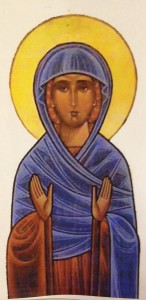Written and researched by Gerald Jarvis.
On behalf of G.V.H.S
Also known as Ceinwen the Fair, Cein the Virgin, and Cein the Bright by the Welsh. She is known as St Keyne to the English or Caginus in Latin.
She was born in AD 461 one of the 15 daughters of King Brychan of South Wales. Cein decided at an early age to dedicate her life to the Church, so when told by her Father the King that she was to marry a local Prince she refused and left her home to set up a religious settlement, and bring Christianity to the West country.
When Cein arrived in the area that is now known as Keynesham she went to the local Lord, and asked for a plot of land to live on, and build her church. Cein was warned by the Lord that the area was swarming with Poisonous snakes, and that neither Man nor Animal was safe there! This statement did not deter Cein. She prayed to God that every snake be tuned to stone! It appeared that this prayer was answered, for by the next morning the snakes had disappeared. Today evidence of many of these ‘stone snakes’ can still be found in the Keynesham area as’ Ammonites.’ *
After some years at Keynesham Cein had built up her religious community. She went on a pilgrimage to St Michaels Mount in Cornwall and while on her way there she caused a well/spring to flow near the village of Lammeton. Now called St Keyne. This well is reputed to have special healing powers for eye complaints.
Water drunk from the well also has the power of conferring Domestic Authority upon the husband or wife, “whichever first drinks of its water on the wedding morning”. A Poet Laureate, Robert Southey (1774-1843) wrote a poem about it in 1798, entitled The Well of St Keyne. This well is still in existence at the present time, although sadly overgrown.
St Cein also had planted around the well 4 trees. An Oak, an Ash, a Willow and an Elm. All these trees have great meaning in Celtic culture and mythology. **
It was while she was at Lametton that another Welsh saint, St Cadog visited her when she was ill, and persuaded her to return to Wales and she eventually agreed.
St Cein made her way back through South Wales and arrived at the village of Allt Yr Esgair. which became Llangeinor (Eglwyskeinor). At the foot of Llangeinor mountain where, she is said to have struck another Holy Well.
She stayed in this area until she died on the 8th of October AD 505. Legend has it that her soul was seen being lifted up to heaven by two angels on a column of fire. St Cadog, who conducted her burial upon Llangeinor mountain, said. that her face in death was as beautiful as it had been in life.
* Turning snakes to stone was very popular amongst saints. The most famous instance is by Hilda, Abbess of Whitby. However St Cein’s ‘Miracle’ predates her by at least two centuries.
Mythology and Trees.
** Ash trees in Celtic mythology were regarded to have healing properties especially for Rickets , and broken bones. In Scandinavian mythology Ash is regarded as the Tree of Life itself.
Elm is regarded as the tree of stability. also known as the Ladies tree.
Oak is for protection and strength, and considered most holy of all trees by the Druids.
Willow is the tree for inspiration and prophecy.
Other shrines to St Cein.
Brecon Cathedral has a stained glass window depicting her turning the snakes to stone.
Keynesham Park in Keynesham has a modern group of wall plaques depicting a very nubile St Cein surrounded by snakes and Ammonites.
St Keynes well, Nr Looe in Cornwall has the actual Holy well.
Laundes Abbey Nr Leicester has a very beautiful painted panel of St Keynes in their Chapel.
St Cein’s Church, at the summit of Llangeinor mountain has recently dedicated an outdoor seating area to her.
Written and researched by Gerald Jarvis.
On behalf of G.V.H.S

Nice one Ger, Keeping the brainbox working – interesting piece